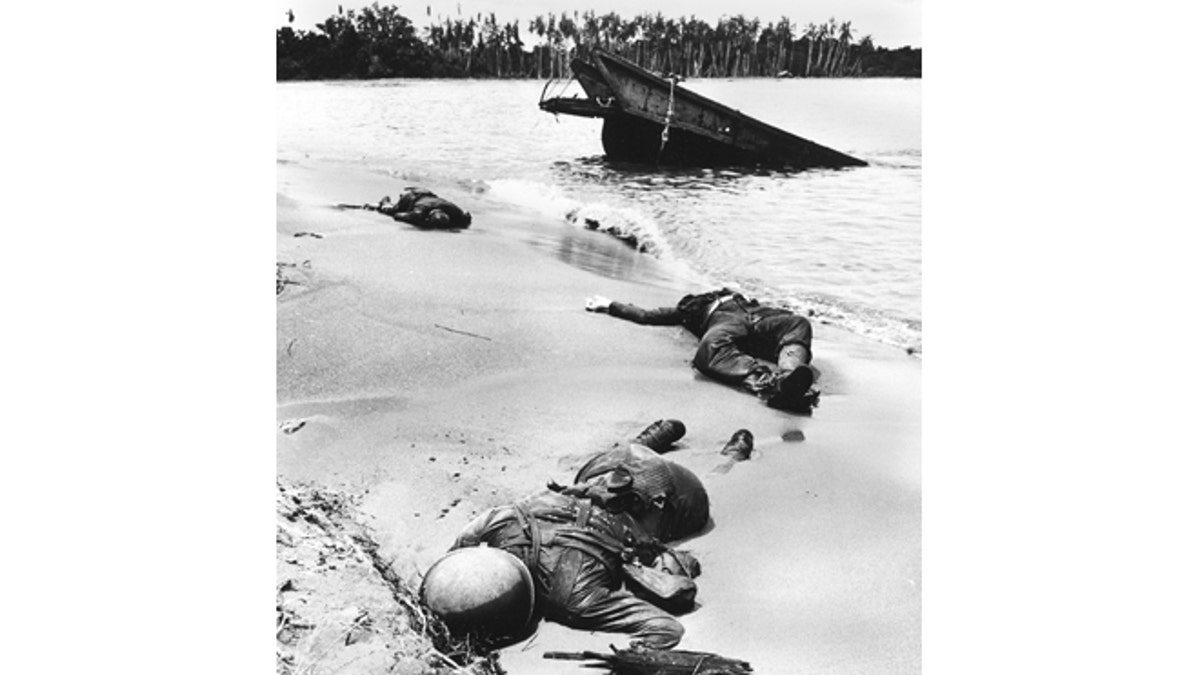
Three dead Americans lie on the beach at Buna. (AP)
Memorial Day, what does it mean? As your long weekend unfolds look around. Take in your world and listen.
What do you see? What do you hear?
Will you hear this long weekend referred to as “the unofficial start of summer?” Will you hear people talk about parties, barbecues, trips to the lake and the beach, probably.
As you feel the warm rays of the sun, smell the inviting flavors of fresh food sizzling on the grill and watch your children run around the yard or splash in the surf there is something you should remember.
It is another beach, from a time long since past. You can see that beach in the photo accompanying this article. It is the beach at Buna, Papua New Guinea, and it depicts just three of the young lives this weekend memorializes.
The photo is of three dead American GIs. They lie half buried in the sand of an island far from their homes, far from their loved ones.
Photographer George Strock's memorable image, taken in February 1943, wasn’t published until September of that year. When it appeared in Life magazine it became the first photo published, during World War II, which depicted dead Americans.
Censors released this and other graphic photos for a number of reasons. Given the year and the war one of those reasons still shocks me every time I read it. President Franklin Roosevelt was concerned that the public had grown detached from the astronomical price being paid by some so that we could live free.
Their faces are hidden, their names were not included.
The photograph was accompanied by an editorial explaining the decision to publish such a horrifying image. It asked the question many readers might have “Why print this picture….” One explanation offered, “Words are never enough.”
“Words are never enough.” As I read and then write that line, I am reminded of the tradition of the moment of silence. It's a time when each one of us is left to our thoughts, when we go to our most private place. When you observe a moment of silence your mind may be filled with prayer or thoughts of those lost and their families.
Or, perhaps, you are filled with that impossible to describe sadness brought on by the memory of someone you loved and can no longer see or hold in your arms.
Australian journalist Edward George Honey is believed to be the person who first suggested observing a moment of silence for fallen soldiers. He did so in a letter to a London newspaper just after the end of World War I. In that letter he proposed, "Five little minutes only…Five silent minutes of national remembrance."
Five minutes would seem an eternity for many in this age of instant everything. And, I don’t mean to judge the time we live in. Rather, I hope that on this Memorial Day, in 201,2 you will share a thought or prayer for those lost.
As the sounds of a long holiday weekend fill the air, I encourage you to locate your moment and in that moment to remember.
Perhaps you will attend a parade or ceremony and pay your respects there.
But if you don’t make it to a formal event you can still take a moment to stop and honor the people for which Memorial Day exits.
If you find yourself at the beach, take a moment to look out over the sand, to the sea and the horizon. As the waves crash remember for a moment the three men on the beach at Buna.
Keep in mind that they are but three of thousands upon thousands who we must always remember.
In some small way I can’t help but think that as we remember them these brave men and women are found again.
And then, when you've finished, if you are lucky enough to be in the company of people you love, break the silence and tell them so.
If your gesture surprises them, or catches them off guard, tell them about the boys on the beach at Buna and how, in some small way, they made the moment possible.
